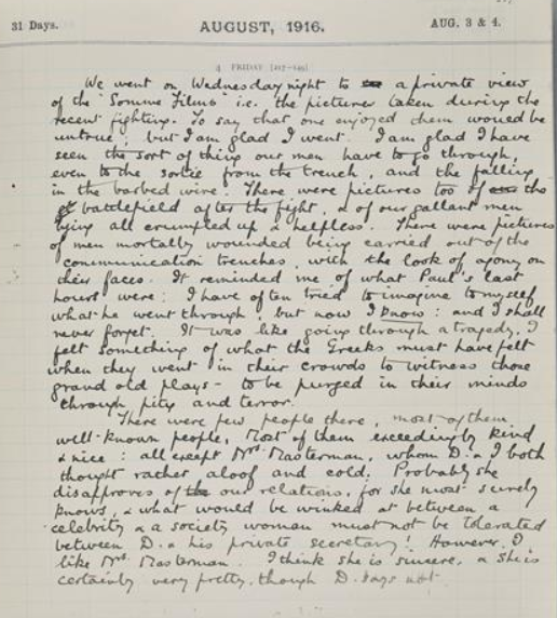Source: Arnold Bennett, Journal 1929 (London: Cassell, 1930), pp. 123-126
Text: London, September. I went by invitation to the “world-première” of an English-written and English-directed talking film, in which Gloria Swanson was the star. The film was apparently made in America. My opinion of Gloria Swanson’s gifts as an actress in silent films is very high indeed. I was bidden for nine o’clock, and at nine o’clock I arrived.
The Street in front of the theatre was crowded with sightseers, some of whom were perched on the tops of lorries used as grandstands. A broad path across the pavement was kept clear by the united efforts of policemen and theatre officials. As I passed between the stalwarts I was the subject of loud remarks from the populace. The big theatre was crowded, except in the best seats round about me, which had been reserved for guests whose names have a publicity value. Many of these empty seats were never occupied during the evening. A silent film was already in progress, and it continued in progress for an hour or so. What qualities it had to recommend itself to my attention I failed to see. However, it did at length finish. Then a gentleman came in front of the curtain and said, inter alia: “Miss Gloria Swanson is in the audience and if you will kindly remain in your seats for one minute after the conclusion of the new film, you will see her.” At these words there was a great noise from the audience — a curious kind of clapping not intended to signify approval. The talking film began. The noise increased. So much so that the film, though it could be seen, could not be heard at all. The film-operator and the audience were equally obstinate for a minute or two. The audience won. Gloria Swanson, who was seated a few rows behind me, stood up in the gangway and bowed. Useless! Half the audience could not see her. The audience grew still more restive. The noise was resentful and imperious. It seemed to say: “She belongs to us. She is ours by right. Show her.”
She left the circle, and was presently seen walking up the central aisle of the floor, well escorted. Then she came before the curtain, obviously in a highly nervous condition, and made a little speech, which was almost inaudible. As soon as she had retired, at least two-thirds of the huge audience on the floor Stood up and hurried from the theatre. They had come to see, not the film, but Gloria Swanson. Having seen her, they departed. Surely rather odd.
The film Started again, to many hundreds of empty seats. I could discover no originality whatever in the film, and no merit except the striking merit of Gloria Swanson’s performance. The story somewhat resembled that of “ East Lynne ”; but it was not as good as “East Lynne”. Crude, tawdry, grossly sentimental, encumbered with stretches of acutely tedious and undramatic dialogue, and rendered ugly by the continuous falsification of the sound of the human voice which mars all talking films, it crawled along from foreseen crisis to foreseen crisis in the most exasperating manner. Its attempts to be noble were merely distressing.
But Gloria Swanson was magnificent in it. She proved that a great star of the silent can be equally great as a star of the talking. She used extreme technical skill, and displayed throughout both real power and real distinction. She even sang. The songs were her one mistake. The film did not demand song, and her singing was amateurish. At the close she appeared once more before the curtain and made another little inaudible speech.
I left the theatre saddened by this spectacle of the waste of a first-rate artist. The space across the pavement was still being kept by policemen and commissionaires. The crowd was larger than before, but order was being maintained. Then suddenly order vanished. The two lines of stalwarts were smashed in an instant, and I was being tossed to and fro in a mass of hysterical women. Gloria Swanson had appeared in the entrance-hall. She fled back. I gave a stalwart one shilling to act as a spear-head for my party through the wild surge. He was not overpaid. In ten seconds we had reached safety. Cries! Shouts! Shrieks! Clapping! Order was restored and Gloria Swanson slipped into the film-star’s immense and luxurious automobile which was waiting for her. What an evening! What a light thrown on the mentality of the film-fan! I restrained my sympathy for Gloria Swanson. She is a queen-empress. She does what she chooses. She is a woman of experience, and she must have known what she was in for.
Comments: Arnold Bennett (1867-1931) was a British writer, best known for his novels of life in the Potteries with its ‘five towns’ that now equate with Stoke-on-Trent. The Gloria Swanson film he saw was The Trespasser (USA 1929), directed by Edmund Goulding. It was made in both silent and sound versions.
Links: Copy at Internet Archive
